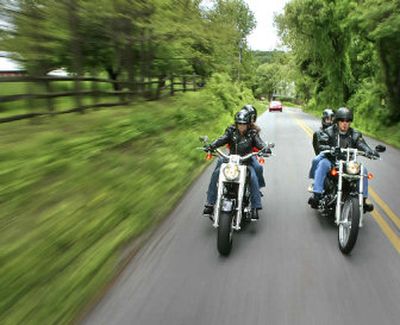Going hog wild

MILWAUKEE – Kari Schwear and her husband Rob took off one day last August on two sets of rented wheels from Harley-Davidson Inc., with their children straddled behind them.
The eight-hour motorcycle ride through the rolling hills of Amish country in Lancaster County, Pa., was an almost forgotten taste of freedom, which they gave up when they sold their 883 Sportster to buy a house in 1999.
“You could smell everything, you know. Just, your whole senses take over,” said Kari, a 38-year-old waitress living in Reading, Pa. “I’d say we put three or four hundred miles on that day. We rode all day. It was great.”
Eight months after renting, the Schwears broke down and bought two bikes, a $16,445 Fat Boy for her, and a $14,995 Night Train for him.
“I knew if I took that step to rent, this was going to happen,” Kari Schwear said.
The iconic motorcycle maker needs to attract more people like the Schwears as it fights flat domestic sales. Analysts have said that if the company wants to stay successful it must broaden its appeal beyond its traditional base of middle-aged men.
The rental program, which started in 1999, is a tool for Harley-Davidson to hook customers on riding and entice them to commit to buying a motorcycle.
“They’re looking to get the experience of riding a Harley out on the open road,” said Lara Lee, Harley-Davidson’s vice president of enthusiast services. “For a lot of people it’s a great way for them to try out the products before they buy.”
Although the renters are primarily men, Lee said, the program does ease the buying process for people who may have just learned to ride on Harley’s Rider’s Edge program – whose clientele is 40 percent female and about 30 percent under the age of 35.
“There are examples of that – learn, rent and then buy,” Lee said.
Analysts say the program helps sales, but just how much is unclear.
“It’s subtle and not measurable, but sure it’s a plus,” said Bob Simonson, an analyst with William Blair & Co.
“But if you look at the retail sales at the dealer level, they’ve been slowing now for two or three years. So it’s not like this has served to either accelerate their business or to prevent it from slowing,” he said.
What is clear is that the rental program has ballooned since starting up six years ago. It has gone from six participating dealerships to 250, including 52 in countries such as France, Italy, Canada, Costa Rica, Australia and Mexico. The motorcycle maker plans to add 20 to 30 participating outlets a year.
Rental days have shot up from 28 in 1999 to 224,134 in 2004.
Harley-Davidson says 32 percent of rental customers they surveyed bought a bike or placed an order after renting, and another 37 percent planned to buy one within a year. About half of the renters spent more than $100 on Harley accessories like T-shirts and gloves.
The program increases dealer inventories, but that’s a boon to dealers who are constantly selling out, Lee said.
Harley-Davidson announced in April it would cut back shipments to dealers due to flat U.S. retail sales, although demand still outstrips supply. Management attributed the cutback to a desire not to have too many 2005 bikes around when the 2006 models came out in June.
Schaeffer’s Harley-Davidson, the Orwigsburg, Pa., dealership where the Schwears rented, has increased its rental fleet to 16 bikes from six bikes just three years ago. More than a dozen renters committed to buying over the last model year, said employee Cherie Schaeffer-Bogotuik.
The rental program boosts the number of bikes it can eventually sell by increasing the number of used bikes in its allocation. Last year, the dealer sold 721 bikes, of which 421 were new and 300 were trade-ins, used, or used by renters.
Increasing inventory is “a great thing,” Shaeffer-Bogotuik said. “It helps us fulfill some peoples’ dreams of getting on a bike.”